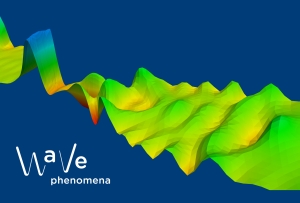The Karlsruhe Institute of Technology (KIT) has successfully acquired funding for a new collaborative research center (CRC). The German Research Foundation (DFG) will finance the CRC “Wave Phenomena: Analysis and Numerics” coordinated by KIT. This is the first CRC in the area of mathematics at KIT. Here, mathematicians in the areas of analysis and numerics cooperate to analytically understand, numerically simulate, and manipulate the propagation of waves. In addition, the DFG has approved the new CRC/Transregio “Waves to Weather”, with KIT as one of the three main partners. It addresses a new generation of weather forecasts.
“Success in this recent CRC funding competition confirms the competence of the scientists involved and underlines the visibility of research at KIT,” says KIT President Professor Holger Hanselka. “We encounter waves everywhere in daily life – even our body does not work without wave phenomena. The new CRC studies these wave phenomena in an comprehensive way.”
Collaborative research centers (CRCs) are research programs of universities scheduled for a duration of up to twelve years (three times four years), in which researchers work on complex topics, crossing the boundaries of disciplines, institutes, and departments. “These CRCs contribute to defining the profiles of the participating universities and to supporting young scientists,” explains KIT Vice President for Research and Information, Professor Detlef Löhe. “The research training group integrated in the ‘Wave Phenomena’ CRC will give young mathematicians the opportunity to profit from stimulating interdisciplinary cooperation.”
The CRC 1173 “Wave Phenomena: Analysis and Numerics” brings together 16 scientists from analysis and numeric of the KIT Department of Mathematics. Another four researchers of optics and photonics, biomedical technology, and applied geophysics work on the interfaces to applications. Two mathematicians from the Universities of Stuttgart and Tübingen will also contribute to the CRC. “Waves are everywhere. Seeing and hearing are based on the propagation of light and sound waves, the human heartbeat is driven by depolarization waves, and most modern communication is based on electromagnetic waves”, says CRC spokesperson Professor Marlis Hochbruck, Head of the Numerical Analysis Research Group of the KIT Institute of Applied and Numerical Mathematics (IANM). “The propagation of waves can be described by differential equations and gives rise to a number of fascinating mathematical problems.”
The goal of the CRC “Wave Phenomena: Analysis and Numerics” is to analytically understand, numerically simulate, and manipulate the propagation of waves under realistic scenarios. The scientists focus on typical wave phenomena such as the emergence of standing and travelling waves or wave fronts, oscillations and resonances, dispersion, wave guidance, reflection, refraction, and scattering of waves.
Transregio “Waves to Weather”
Enhancing the precision and reliability of weather forecasts is the objective of the new CRC/Transregio 165 “Waves to Weather” (W2W), in which scientists of KIT, Ludwig-Maximilians-Universität München (LMU) as coordinator, Technische Universität München (TUM), the German Aerospace Center (DLR) Munich, and Johannes Gutenberg University (JGU) Mainz cooperate in a transregional manner. “The socio-economical relevance of weather forecasts is increasing, which is not least due to the transformation of the energy system,” explains Professor Peter Knippertz, Head of the Working Group on Atmospheric Dynamics within the Troposphere Research Division of the KIT Institute of Meteorology and Climate Research (IMK-TRO). W2W concentrates on the presently biggest challenge in weather forecasting: Identifying the limits of predictability in particular of wavelike air movements in various situations and making the physically best possible predictions.
Being “The University in the Helmholtz Association”, KIT creates and imparts knowledge for the society and the environment. It is the objective to make significant contributions to the global challenges in the fields of energy, mobility, and information. For this, about 10,000 employees cooperate in a broad range of disciplines in natural sciences, engineering sciences, economics, and the humanities and social sciences. KIT prepares its 22,800 students for responsible tasks in society, industry, and science by offering research-based study programs. Innovation efforts at KIT build a bridge between important scientific findings and their application for the benefit of society, economic prosperity, and the preservation of our natural basis of life. KIT is one of the German universities of excellence.

